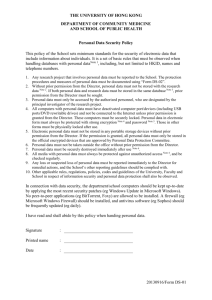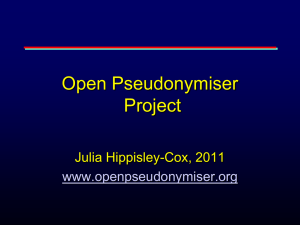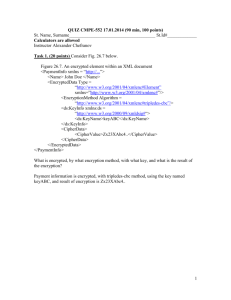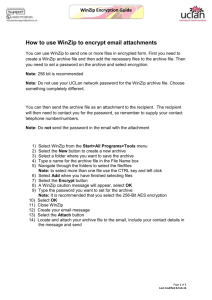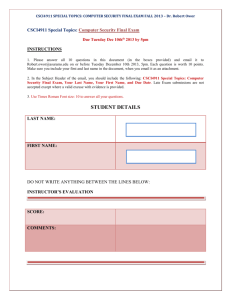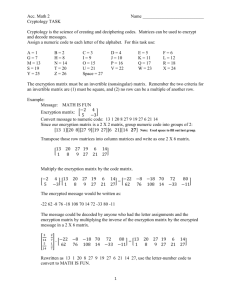Attacks on WinZip encryption
advertisement
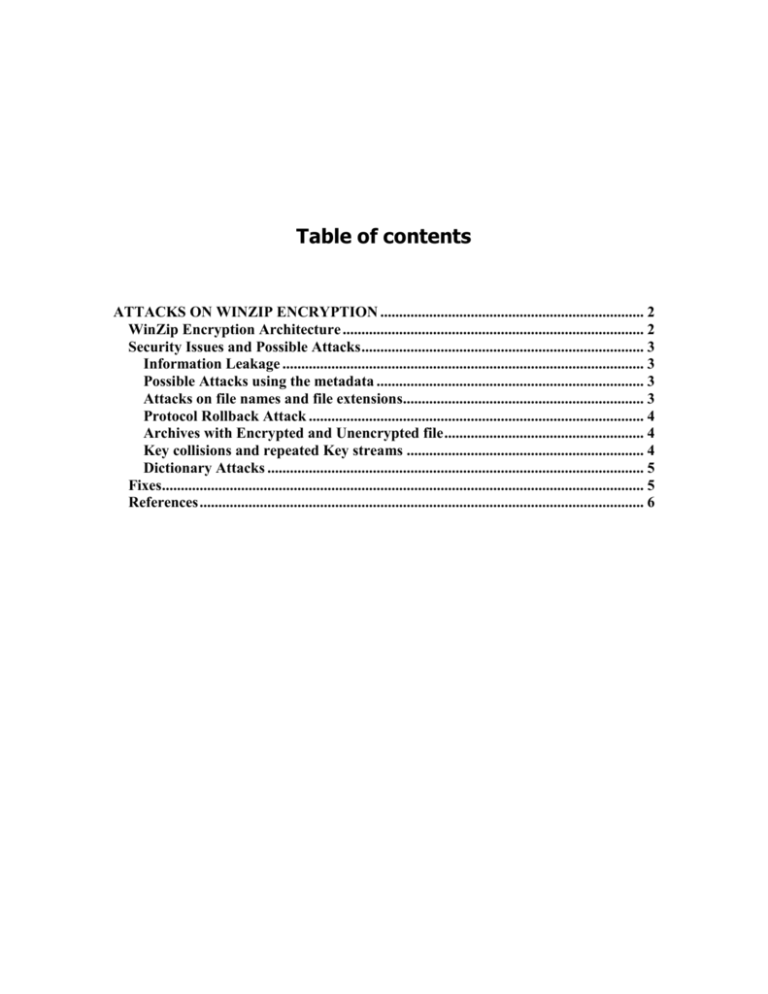
Table of contents ATTACKS ON WINZIP ENCRYPTION ...................................................................... 2 WinZip Encryption Architecture ................................................................................ 2 Security Issues and Possible Attacks ........................................................................... 3 Information Leakage ................................................................................................ 3 Possible Attacks using the metadata ....................................................................... 3 Attacks on file names and file extensions................................................................ 3 Protocol Rollback Attack ......................................................................................... 4 Archives with Encrypted and Unencrypted file ..................................................... 4 Key collisions and repeated Key streams ............................................................... 4 Dictionary Attacks .................................................................................................... 5 Fixes................................................................................................................................ 5 References ...................................................................................................................... 6 ATTACKS ON WINZIP ENCRYPTION WinZip has recently released WinZip® 9.0 beta version, in which it is using the encryption scheme AE-2 to encrypt the compressed files. The purpose of this paper is to explain the attack on WinZip’s latest encryption method, Advanced Encryption (AE-2) and briefly suggest some solutions. WinZip is a common compression utility on Microsoft windows machines. Even though the encryption schemes used in WinZip are very secure, the implementation of these schemes in WinZip encryption makes it vulnerable to many side channel attacks and “man in the middle “attacks. WinZip Encryption Architecture WinZip 9.0 compresses files using “enhanced deflate” method [1], encrypts those compressed files independently and then archives into the WinZip archive. After the files are compressed AE-2 encryption scheme is invoked to encrypt these files.AE-2 uses 128,192 or 256 bit key to encrypt and 64-bit extensions to zip file to store unlimited data in the zip file [1]. WinZip derives AES and HMAC-SHA1 keys from the user’s password and then encrypts the output of the compressed files with AES in CTR mode. The lengths of the compressed data and the encrypted data (after compression) are same. After encryption it authenticates the resulting cipher text with HMAC-SHA1 key. AES-CTR and HMAC-SHA1 together protects both privacy and integrity of the data. Every encrypted file in WinZip contains information about the “salt value”,”password verification value”, “encrypted file data” and “authentication code” [1]. Length of salt value changes according to the key size. If the key size is 128 bytes salt is 8bytes, for 192 bits 12bytes, for 256 bits 16 bytes. Password verification value is a two byte value, derived with the encryption password and stored in encrypted file [1], before decrypting verification value is derived from the decrypting password and verified with the value stored in encrypted file. Encrypted file data value is the size of the compressed, encrypted files which is a variable size. Authentication code checks that the contents of an encrypted file have not been changed since they first encrypted [1]. This is a super CRCcheck on the data in the file after compression and encryption [1]. All this encrypted files and information about these files are stored in WinZip archive’s “main file record” and “central directory record” [2]. To reduce the zip file size WinZip does not encrypt directories and folders as a result the archives contain both encrypted and unencrypted files. This AE-2 encryption is not using the CRC value and is set to “zero” [1]. 2 Security Issues and Possible Attacks Information Leakage The main cause of information leakage in WinZip is that the metadata of the encrypted file appears in plaintext in WinZip’s archive. This metadata contains encrypted file’s original file name, length of the original plaintext file, length of the cipher text data, last modification date and time etc. Availability of this Meta information in plaintext makes the attacker’s life easy. Using the length of an uncompressed data stream and the length of the compressed output, Attacker can learn information about the uncompressed data. Possible Attacks using the metadata The information contained in the metadata such as chosen compression method and the length of the original file are not authenticated by HMAC-SHA1.This might give a way to “man in the middle” attack. The compression method and the original filed lengths are not authenticated. So Attacker can easily change these fields. The attack can be as follows: suppose if Alice encrypts file “info.zip”, compresses and sends to Bob, an attacker can intercept that file in between and can change the original field length of the file, value of the compression method field in “info.zip” and send that “newinfo.zip” file to Bob. Bob tries to decrypt that file. If the values changed by Attacker are correct or if the extraction tool does not check that field and decompresses the file, MAC will match and doesn’t give any error to Bob, but as the value of the compression method has been changed in this new file, the file will be decompressed using the wrong algorithm and as a result Bob gets some garbage values. Then if Bob might sends an email to Alice explaining the problem, Attacker again can intercept the message and emails him back pretending to be Alice and asks Bob to send the garbage data so that he can resolve it. Then Bob sends the file (assuming it to be garbage data) to the Attacker who can change the data he has initially changed and can retrieve the original data. Attacks on file names and file extensions From WinZip archives Attacker can easily modify the extensions of the file names or can change the file name itself as AE-2 encryption does not authenticates the metadata of the file’s filename. As a result the receiver can’t open the file or can’t get the exact contents as sent by the sender. For example if a file name is report.ppt, Attacker can easily change that .ppt extension to .prf, which makes the receiver can’t open that file or get a garbage 3 value. So authenticating the file name and encrypting the file name might resist this attack. Protocol Rollback Attack AE-2 implemented in such a way that files encrypted with AE-1 must be able to decrypt with AE-2 encryption method, so an Attacker can force WinZip to use AE-1 decryption method on AE-2 encrypted files. AE-1 uses standard CRC check while decrypting the message. This CRC filed contains original CRC of the unencrypted data. Based on this the attack can be as follows: Alice sends a text.zip file to Bob, Attacker intercepts that file, changes the version number, extra data field, CRC field of that file by calculating the 32-bit CRC of his guessed data and sends to Bob, if Bob is able to decrypt that file, that means CRC matches .So, Attacker can know that his guess is correct. If Bob is not able decrypt the file and gets an error message he can find the error by looking into detailed error log and can send that error to Alice .Then Attacker can intercept that error message and he will come to know that the CRC is failed and he can learn the CRC of the plaintext file. Based on the previous knowledge the attacker has, he can guess and try all possible values of the data to find the original data. In this attack all the Attacker has to know is whether Bob could decrypt the message or not. Archives with both Encrypted and Unencrypted files WinZip encrypts on a per file basis, encrypting some files and leaving others unencrypted. As a result WinZip Archives contain both encrypted and unencrypted files. When Attacker enters the correct password WinZip extracts all encrypted and unencrypted files, and Attacker can have full control over those files i.e. if the archive has 5 files encrypted and 2 filed unencrypted WinZip asks for the password to extract all the files as 5/7 files are encrypted. Now Attacker can replace one encrypted file with the new unencrypted file of his choice of data, which doesn’t make any difference to the receiver as WinZip still asks for the password and the receiver thinks that the files extracted are correct. Key collisions and repeated Key streams As specified at the beginning, WinZip uses 128, 192, 256-bit keys. To encrypt a file WinZip takes the password combines with some random sequence of bytes to derive the AES and HMAC-SHA1 keys. This random sequence of bytes is called “salt value” [1] and is stored unencrypted. So two different files encrypted with the same password will use different encryption and authentication keys. When using AES with 128 bit keys, the probability for key collision to occur after 232 files are encrypted is very high, especially when AES is combined with CTR mode and initial counter for CTR mode is zero all the time. The key streams can be reused after encrypting 232 files. If we use 256 bit key, collision can occur at most after 264 files are encrypted. So repetition of key streams and 4 repetition of encryption and authentication keys occurs. Through this repetition Attacker can learn information about the encrypted and compressed plaintext. Dictionary Attacks The purpose of using salt value while deriving the AES and HMAC-SHA1 keys is to make attacker’s life hard in finding and computing the dictionary for HMAC-SHA1 and try all possible combinations of salt values. Different salt value is used to encrypt each file. So the attacker doesn’t have to try all the possible combinations of salt value. “In particular, attacker would only need to populate the dictionary using enough different salt values to ensure, with high probability, that one of the salt values that a user uses when encrypting her files will collide with one of the salt values that attacker used when creating his dictionary”[2]. Fixes It would be impossible to fix all the problems discussed above, as fixing one might cause other type of problems. We can’t avoid attacks totally so here we can only minimize the amount of attacks or information leakage through some fixes. The metadata in WinZip archives is not encrypted. So the file name extension, date and time of the modified file, file names etc. are in plaintext in this metadata. The encryption utility should also protect the integrity of the metadata. Encryption of this metadata might avoid some of the above attacks such as information leakage, changing file names etc. The authenticating algorithm HMAC-SHA1 should authenticate all the information that the extractor will use when reconstructing the original data. Since WinZip uses compression type field when extracting the encrypted file, the compression value must be MACed along with the cipher text of the compressed files. To avoid protocol rollback attack, diversifying the AES and HMAC-SHA1 keys might be a good fix [2]. “AES and HMAC-SHA1 keys derived from some password and salt using the new encryption method will be different from the keys derived from the same password and salt when using the AE-1 and AE-2 encryption methods”[2]. If the length of the salt is variable and this length is encoded in metadata field, this solution may not work because Attacker can simply add this vendor ID, encryption strength field, and the version into the salt in AE-2 archive. WinZip creates “Main file record” & “Central directory record” for every file while it is archiving the files [2]. The “main file record” contains the meta data of the file and “central directory record” contains this meta data along with the location of the file’s corresponding main file record in Zip archive. According to WinZip specification, it never warns the user that the archive has both encrypted and unencrypted files, which 5 might cause the attack stated above in this paper. To avoid this attack the user must be warned about the archive that it has both encrypted and unencrypted files. Another solution can be authenticating both “central directory record” and “main file record” which might reduce the efficiency in maintaining and updating the large archives. To overcome this issue we can only authenticate “central directory records” of all files together using MAC algorithm but this also might have some issues. To avoid the key stream repetition the possible solution can be to increase the salt length and making the initialization CTR value random. If we are using the 128-bit key value then after encrypting 232 files, the probability that repetition of key streams is very minimal to occur, as CTR value is changing randomly. When the length of the salt is doubled, the repetition of salt value problem can be solved. Finding the salt value through exhaustive search can also be solved because it is hard for the attacker to find the salt value by trying all the combinations on a bigger / lengthier value. Encrypting the “central directory record” only can’t be the solution for reducing the information leakage because the main file record also contains the metadata information of the file. Encrypting both central directory record and main file record will get into the issue discussed above in this paper. So the possible solution to reduce the information leakage can be to encrypt the entire “central data directory records” and remove the meta data information from main file record and replace them with some random data by using some tools like PKWARE®. The encrypted data should be parsable with WinZip. To achieve this, we might need to modify the main file and central directory records such that the resulting archived data must be parsed with the WinZip specification. References 1. http://www.winzip.com/aes_info.htm#non-files 2. www.cse.ucsd.edu/users/tkohno/papers/WinZip/ 3. http://www.winzip.com/whatsnew90.htm All the information in this paper is taken from the references given above. 6
